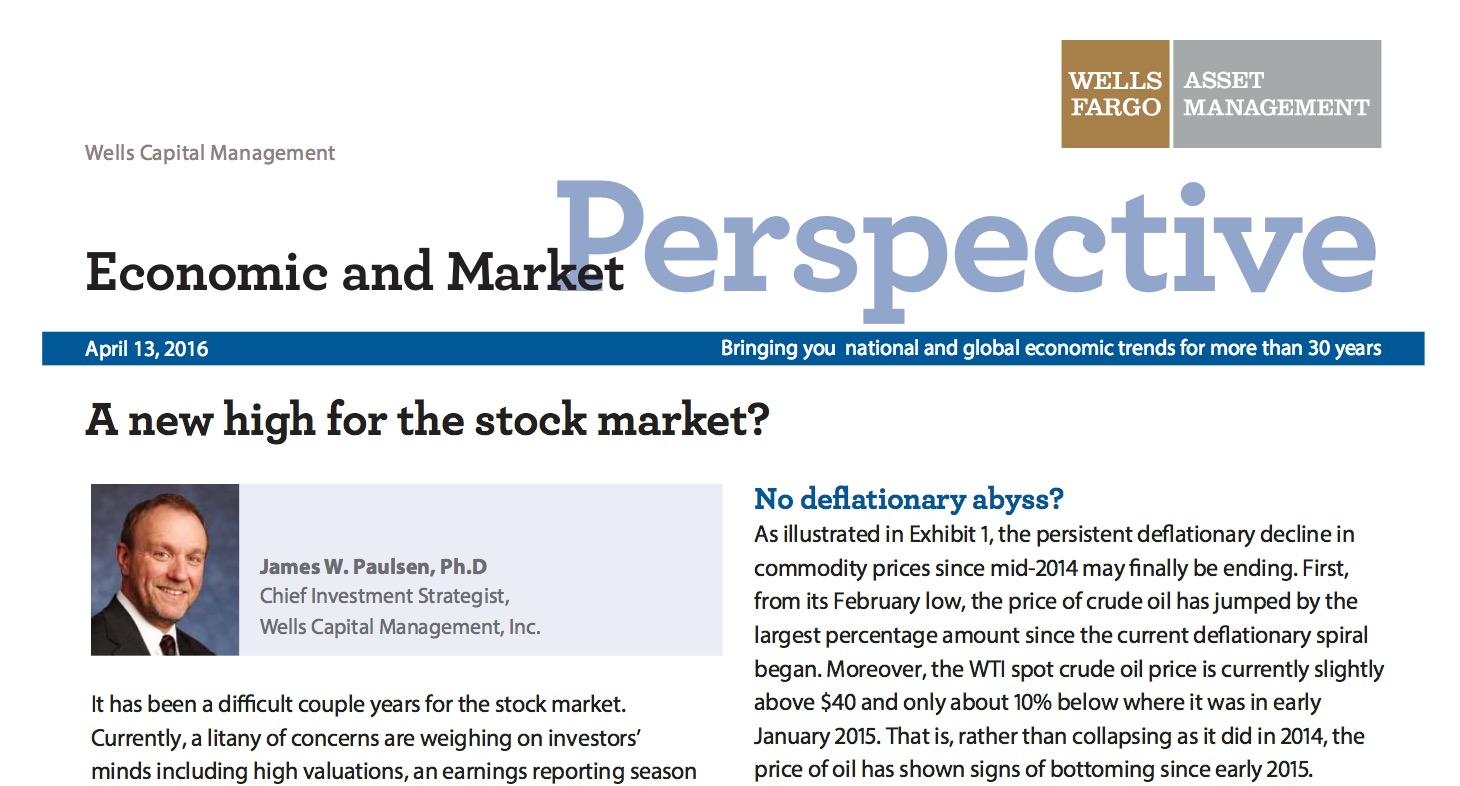A new high for the stock market?
by James Paulsen, Chief Investment Strategist, Wells Capital Management
It has been a difficult couple years for the stock market. Currently, a litany of concerns are weighing on investors’ minds including high valuations, an earnings reporting season beginning this week destined to be lousy, a very weak first quarter U.S. real GDP number, continued evidence of sluggish economic growth about the globe, monetary policies which increasingly appear overextended, ineff ective, and scary (negative interest rates?), and a process aimed at picking the next leader of the free world which oddly is both entertaining and frightening (and yes, Panama papers, Brexit, ISIL, and North Korean missile tests).
We continue to expect a relatively flat stock market this year with the S&P 500 ranging from about 1800 to 2200 and ending the year about where it started at 2050. We are also mindful that predicting short-term stock market movements are often a fool’s game and consequently only worthy of marginal portfolio adjustments. However, currently, we suspect the stock market may soon break to new record highs near the upper end of our forecasted trading range. Several forces could help improve near-term momentum in the stock market. First, the deflationary undertone dominating investor mindsets in the last couple years seems finally to be easing as commodity prices show signs of recovery. Second, some factors now suggest earnings performance may begin to improve during the balance of this year. Third, economic surprise indexes recently show that global economic momentum may be headed for a synchronized bounce. Finally, fear is increasingly evident in the stock market reestablishing the bedrock of this bull market — climbing a perpetual wall of worry!
No deflationary abyss?
As illustrated in Exhibit 1, the persistent deflationary decline in commodity prices since mid-2014 may finally be ending. First, from its February low, the price of crude oil has jumped by the largest percentage amount since the current deflationary spiral began. Moreover, the WTI spot crude oil price is currently slightly above $40 and only about 10% below where it was in early January 2015. That is, rather than collapsing as it did in 2014, the price of oil has shown signs of bottoming since early 2015.
Second, and perhaps most important, is the recent significant surge in raw industrial commodity prices. The CRB Raw Industrial Commodity Price Index has risen by about 12.5% from its low in late November. This is the largest increase in industrial prices since commodity prices peaked and it is indeed a very encouraging sign that those prices most sensitive to economic activity (i.e., industrial commodity prices) have been rising now for the last four to five months!
Third, U.S. dollar strength has been at the epicenter of the collapse in commodity prices and it is no coincidence commodity prices bottomed earlier this year when the broad U.S. dollar peaked. The U.S. dollar has recently suff ered its largest pullback against both developed and emerging currencies since commodity prices peaked and we expect the dollar to continue to weaken during the balance of this year.
Fourth, the significant jump in international freight rates suggest deflation pressures may also be easing about the globe. Is U.S. importation of deflationary pressures coming to an end? Finally, as shown in Exhibit 2, U.S. core cost pressures are no longer decelerating. Both core consumer price and wage inflation have accelerated significantly in the last year consistent with the economy returning to full employment.
In the last couple years, deflation has weighed heavily on the financial markets. A strong U.S. dollar and weak commodity prices have heightened investor concerns regarding a potential global deflationary abyss, led foreign officials to adopt negative interest rate policies and forced the U.S. Fed to pause tightening plans, depressed corporate earnings results, lowered inflation expectations, widened corporate bond yields spreads, and contributed to persistent declines in equity mutual fund flows.
In short, deflation and fear of deflation has shaped investor behaviors. If this primary trend of the last couple years is finally ending, investor attitudes and actions could become much more aggressive and optimistic. If commodity prices are indeed bottoming, will “risk-on” once again become vogue, will earnings expectations accelerate, will equity fund flows improve, and will stock market leadership shift from defensive toward cyclical sectors?
Read/Download the complete report below:
Copyright © Wells Capital Management












